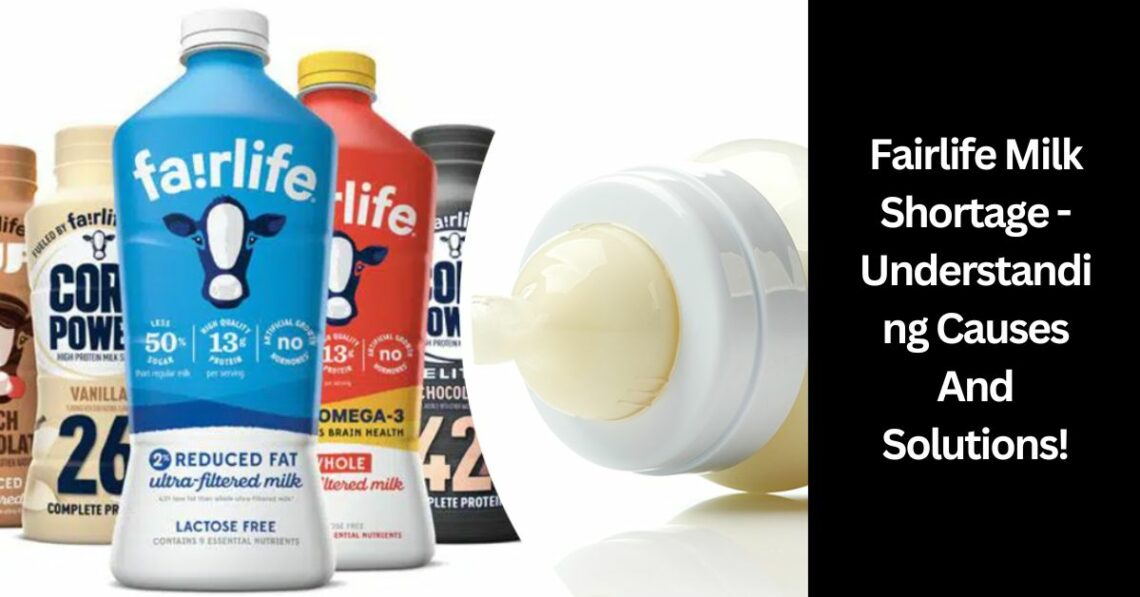
Fairlife Milk Shortage – Understanding Causes And Solutions!
In recent times, the dairy aisle of supermarkets has witnessed a notable absence – the scarcity of Fairlife milk.
This unexpected shortage has left consumers wondering about the reasons behind the empty shelves and how it might impact their daily lives.
The Fairlife milk shortage results from high demand, supply chain disruptions, and the global pandemic.
Empty shelves highlight the need for clear communication, innovation, and consumer adaptation to navigate this scarcity.
In this in-depth exploration, we delve into the intricacies of the Fairlife milk shortage, examining its causes, potential consequences, and what steps are being taken to address the issue.
Table of Contents
ToggleFrom Boom To Bust – Understanding Fairlife’s Popularity!
Over the past few years, Fairlife has emerged as a popular choice among consumers seeking a protein-rich, lactose-reduced milk option. The brand’s unique filtration process and commitment to quality have contributed to its success.

However, this rise in popularity has also set the stage for challenges, leading us to the current shortage dilemma.
Fairlife has struggled to keep up with the demand, leading to shortages of the product in many areas. As a result, consumers have had to turn to other brands or look for alternative sources of protein.
Also Read: IS TRISH MCEVOY GOING OUT OF BUSINESS – ULTIMATE GUIDE!
The Demand Surge – A Blessing And A Curse!
Fairlife’s sudden surge in demand can be attributed to a growing health-conscious consumer base. With an increased focus on protein intake and lactose sensitivity, Fairlife became a preferred choice for many.
This heightened demand, however, has strained the brand’s production and distribution capabilities, resulting in empty shelves across grocery stores.
Fairlife is working to meet this increased demand by expanding its production and distribution capabilities. They are also exploring new technologies such as automation to streamline their operations and ensure sufficient supplies.
Behind The Scenes – Causes Of The Fairlife Milk Shortage!
Fairlife, like many other food products, relies on a complex supply chain to bring its products from farms to consumers.
Any disruption in this delicate network can lead to shortages. Issues such as transportation challenges, shortages of key ingredients, or disruptions in processing plants can contribute to the current scarcity of Fairlife milk.
The Ripple Effect of Pandemic Woes:
The global pandemic has cast a long shadow over various industries, and the dairy sector is no exception. Supply chain disruptions, labor shortages, and fluctuations in demand have created a perfect storm for the dairy industry, impacting the production and distribution of products like Fairlife milk.
Transparent Communication – Bridging The Gap!
To address consumer concerns and foster trust, Fairlife must engage in transparent communication. Keeping consumers informed about the reasons behind the shortage, steps being taken to resolve the issue, and an estimated timeline for recovery can go a long way in maintaining brand loyalty.

Additionally, Fairlife should strive to ensure that any potential issues are quickly resolved and that customers receive timely updates.
The company should also create an FAQ section on their website to answer common questions and provide additional resources to customers. Finally, Fairlife should strive to provide excellent customer service to ensure that customers feel heard and supported.
Diversification and Resilience:
To mitigate future shortages, Fairlife may need to explore diversification strategies. This could involve securing additional suppliers, optimizing production processes, or even introducing alternative products that align with consumer preferences.
Also Read: IS ACCUQUILT GOING OUT OF BUSINESS – UNRAVELING THE SPECULATIONS!
Navigating The Future – Lessons Learned!
The Role of Technology in Supply Chain Resilience:
The Fairlife milk shortage underscores the importance of leveraging technology in building a resilient supply chain.
Innovations such as data analytics, IoT sensors, and blockchain can enhance visibility, efficiency, and responsiveness, helping brands like Fairlife better navigate challenges in the future.
Consumer Adaptation – Exploring Alternatives!
In the face of a Fairlife milk shortage, consumers are forced to adapt. Exploring alternative dairy products or considering homemade options can not only provide a temporary solution but also encourage a more diverse and resilient food ecosystem.
FAQ’s:
Q1. Why is there a shortage of Fairlife milk?
The shortage of Fairlife milk is a result of increased consumer demand, supply chain disruptions, and the impact of the global pandemic. These factors have created challenges in production, distribution, and overall availability.
Q2. How long will the Fairlife milk shortage last?
The duration of the Fairlife milk shortage is uncertain and depends on various factors, including the resolution of supply chain issues, production ramp-up, and external influences. Consumers are advised to stay informed through official updates from the brand.
Q3. What alternatives are available during the Fairlife milk shortage?
Consumers can explore alternative dairy options during the Fairlife milk shortage, such as other brands, types of milk, or even consider homemade alternatives. This period presents an opportunity to discover new products and flavors.
Conclusion:
Let’s Sumup,
The Fairlife milk shortage highlights supply chain challenges. Brands need transparency, innovation, and diversification. Consumers should stay informed, explore alternatives, and adapt for a resilient dairy future.
You May Also Like

Ndgvli – Everything Is Here To Know!
March 12, 2024
Insurance Vietnamtimes – Check It Out In 2024
January 23, 2024

